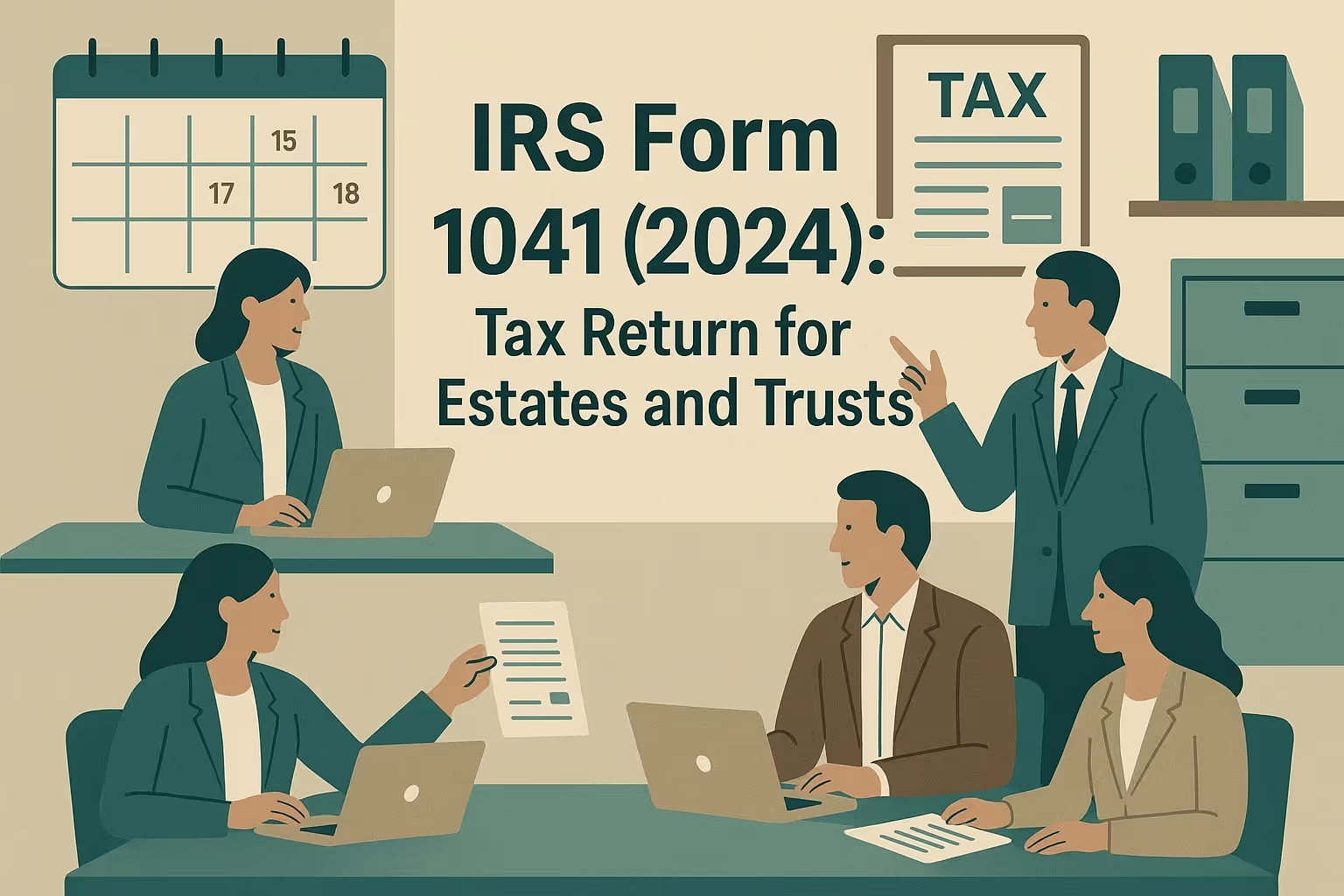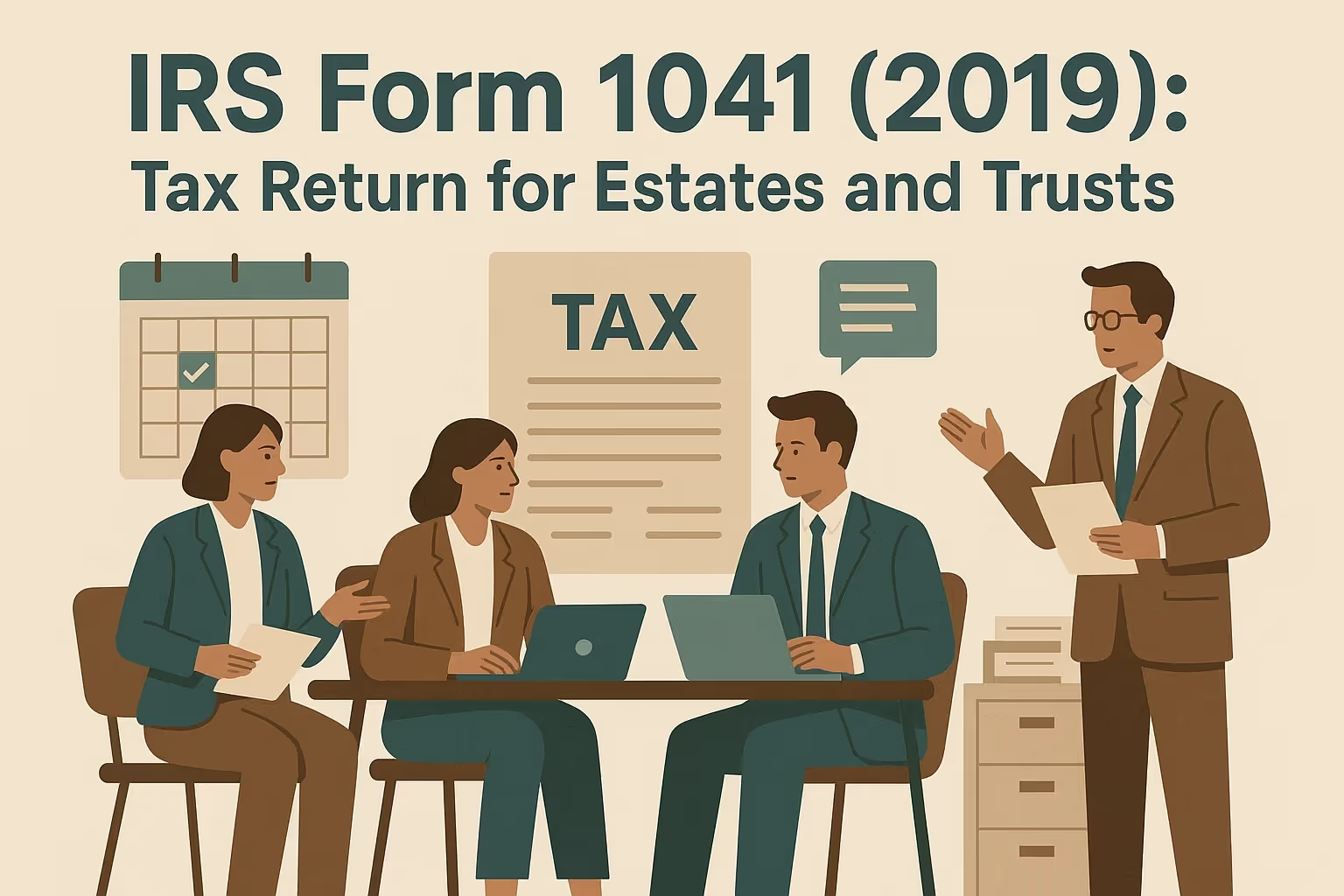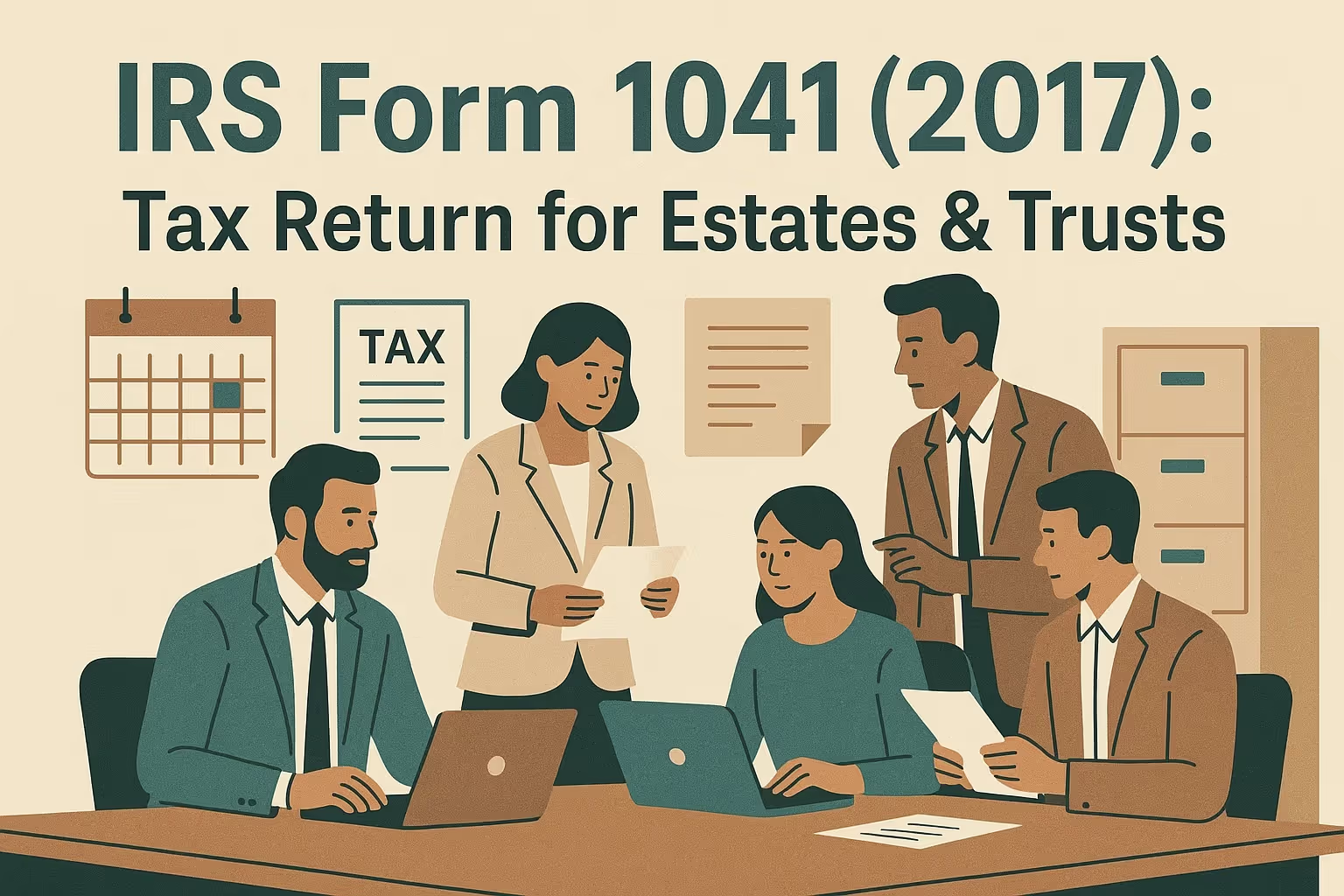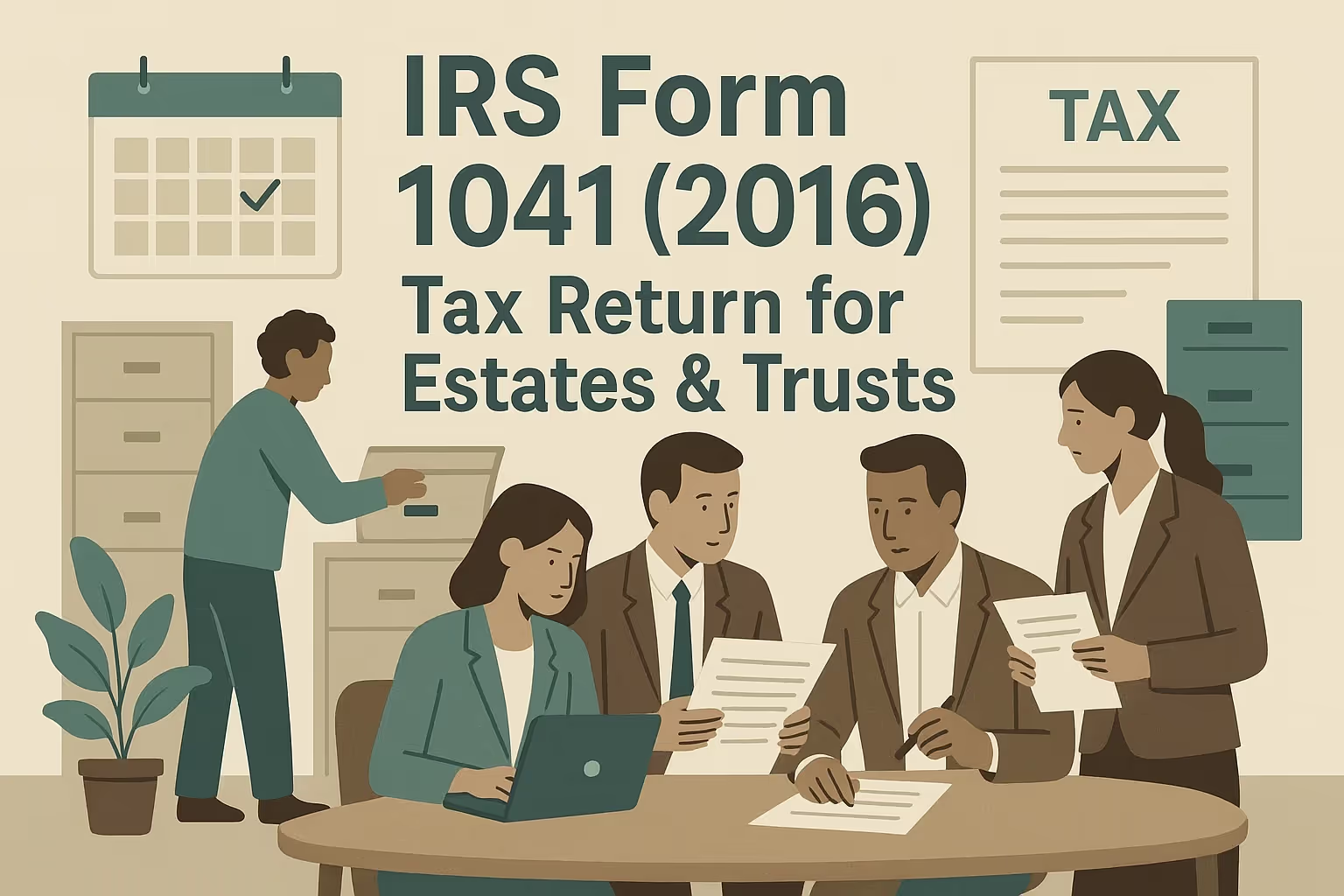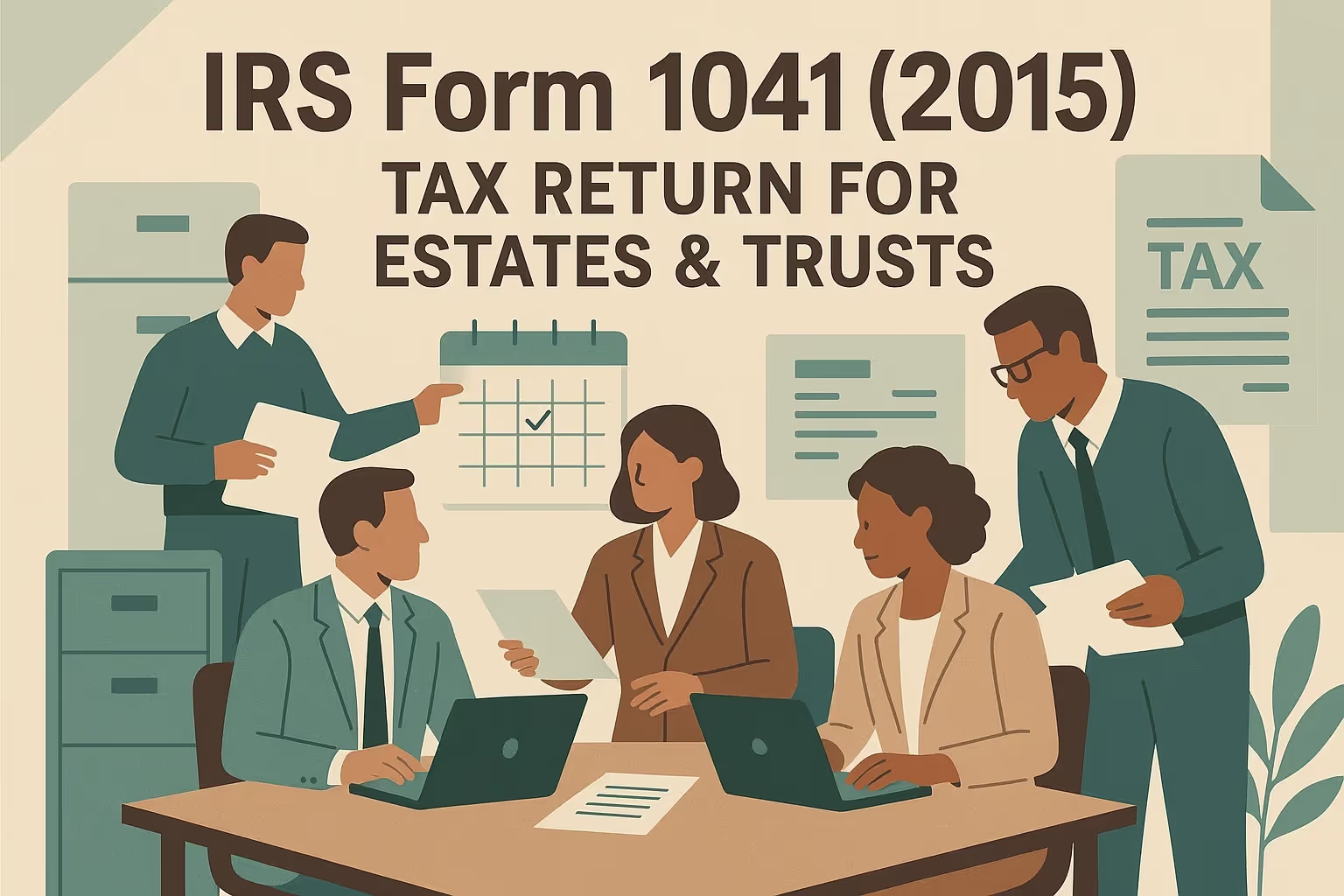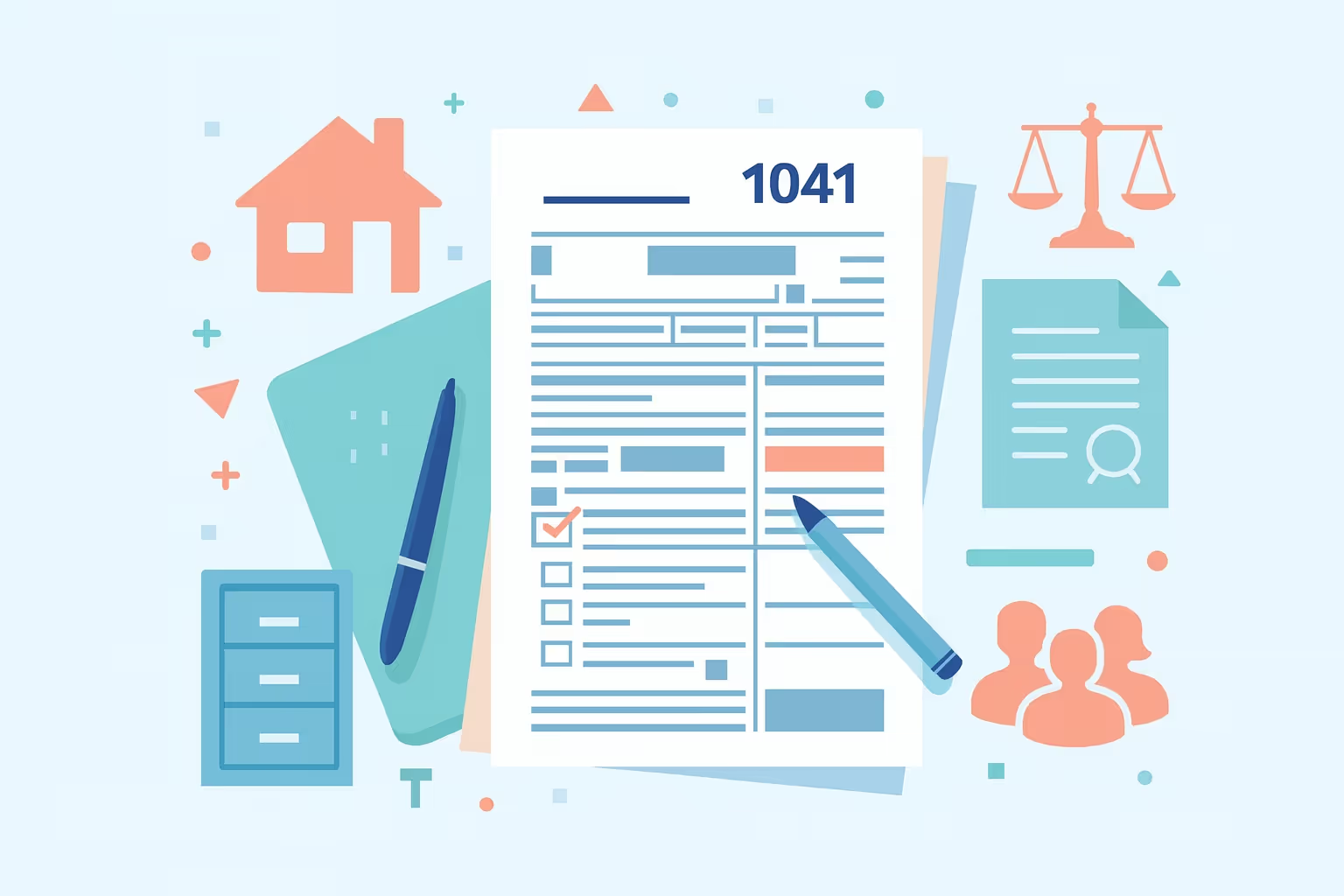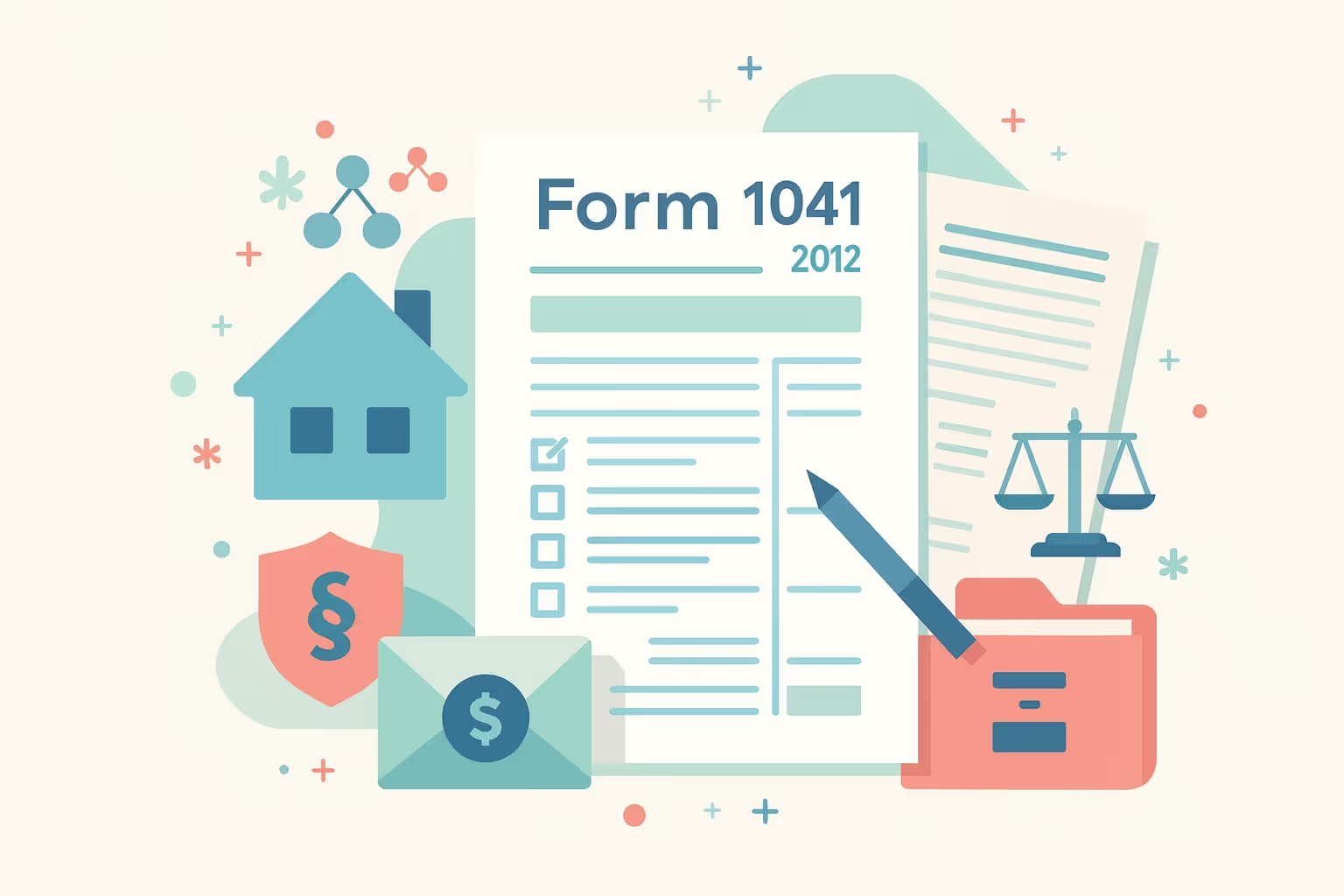Form 1041 2018 Instructions: Guide for Estates and Trusts
Filing Form 1041 can feel complicated for those handling an estate or trust for the first time. This essential income tax return reports income, deductions, and distributions made by estates and trusts during the tax year. It helps the Internal Revenue Service ensure that the correct amount of taxes is paid on income earned or distributed, while also allowing beneficiaries to receive accurate tax information for their own returns.
For the 2018 tax year, several updates under the Tax Cuts and Jobs Act changed how estates and trusts calculate deductions, capital gains, and allowable expenses. Fiduciaries must understand these adjustments to file correctly and avoid common errors that can lead to penalties or processing delays. Learning how to prepare and file Form 1041 accurately helps ensure compliance, supports accurate refunds, and protects both the fiduciary and beneficiaries.
This guide provides step-by-step instructions for completing Form 1041 for the 2018 tax year. It covers who must file, how to report income and deductions, and how to submit payments or extensions. With the proper preparation, expert help, and reliable software, fiduciaries can complete the process smoothly, ensuring accuracy and timely filing.
Understanding Form 1041
Form 1041, officially titled the U.S. Income Tax Return for Estates and Trusts, is used by fiduciaries to report the income, deductions, and tax liability of an estate or trust. It functions similarly to the Form 1040, which individuals file. Still, it applies specifically to estates and trusts that earn income after a person’s death or while assets are held in confidence.
What Form 1041 Reports?
Form 1041 records the financial activity of an estate or trust throughout the year. It reports income earned from several sources, including:
- Interest and dividends: This includes earnings from bank accounts, bonds, or stocks held by the estate or trust.
- Business or rental income: Estates and trusts must report profits from businesses or properties they own or manage.
- Capital gains: When property, investments, or other assets are sold for a profit, the gains must be reported on the form.
- Deductions and credits: Certain expenses, such as administration costs, taxes, and charitable contributions, can reduce taxable income.
The Purpose of Filing
The primary purpose of filing Form 1041 is to ensure that income generated by an estate or trust is taxed correctly, whether it remains in the entity or is distributed to beneficiaries. This filing also determines the amount of tax owed to the IRS and what income must be reported by beneficiaries on their personal tax returns.
Accurate preparation of Form 1041 ensures proper reporting of income and deductions, helps avoid penalties, and protects the financial interests of both fiduciaries and beneficiaries. It also provides clear documentation that the estate or trust fulfilled its legal tax obligations for the year.
Who Must File Form 1041 for 2018?
Filing Form 1041 is required when an estate or trust meets certain income or beneficiary criteria. The IRS requires fiduciaries to file when the entity earns income that reaches a specific threshold or involves certain types of beneficiaries.
Estates
An estate must file Form 1041 if it has:
- Gross income of 600 dollars or more during the tax year.
- Any beneficiary who is a nonresident alien.
This means that even if the estate has not distributed income yet, the fiduciary must still report earnings such as dividends, interest, or capital gains.
Trusts
A trust must file Form 1041 if it has:
- Any taxable income for the year.
- Gross income of 600 dollars or more, regardless of whether tax is owed.
- At least one nonresident alien beneficiary.
Trusts classified as grantor-type trusts may have different filing requirements. In many cases, the grantor reports the income directly on their individual return rather than through Form 1041.
Special Cases
Certain entities have unique rules:
- Qualified disability trusts can claim a higher exemption limit.
- Bankruptcy estates are required to file when their gross income equals or exceeds the threshold set for individuals.
Fiduciaries should carefully determine whether filing is required to ensure compliance with IRS regulations and to avoid penalties for late or missed filings.
What’s New for 2018?
The tax year 2018 introduced significant changes under the Tax Cuts and Jobs Act, which affected how estates and trusts report their income and deductions. Fiduciaries must understand these updates to accurately prepare the return and avoid errors that can affect refund amounts or create additional tax liabilities.
Key Tax Law Changes
- Qualified Business Income deduction: Estates and trusts became eligible for up to a 20 percent deduction on qualified business income, real estate investment trust dividends, and certain partnership income.
- Net Operating Loss rules: Carrybacks were eliminated for most entities, allowing only carryforwards of net operating losses.
- Suspension of miscellaneous deductions: Many itemized deductions subject to the two-percent floor were removed, though administration expenses under section 67(e) remained deductible.
Updated Rates and Deduction Limits
- The deduction for state and local taxes was limited to $10,000.
- The exemption amounts remained low, with simple trusts at $300, complex trusts at $100, and estates at $600.
- Capital gains were taxed at 0%, 15%, or 20% depending on income thresholds.
Fiduciaries must apply these 2018 rules when preparing the return to ensure accuracy and compliance. Misapplying the new deduction and loss rules may lead to incorrect tax calculations and delays in processing.
Step-by-Step Instructions for Completing Form 1041
Preparing Form 1041 requires gathering accurate records, entering information carefully, and thoroughly reviewing the form for completeness. Each step ensures the tax return reflects the estate’s or trust’s financial activity for the year.
Step 1: Gather Required Documents.
Before starting, fiduciaries should collect:
- The will or trust document and any amendments.
- An Employer Identification Number (EIN) for the estate or trust.
- All income records, such as interest statements, dividend reports, and sale confirmations.
- Expense records for administrative costs, taxes, and fiduciary fees.
- Details of distributions made to beneficiaries.
- The prior year’s Form 1041, if applicable.
Step 2: Complete Entity Information.
Enter the estate or trust name, fiduciary information, address, and EIN. Check the appropriate box for the entity type, such as estate, simple trust, or complex trust. Mark the boxes for initial, final, or amended returns as needed.
Step 3: Report Income.
Report all types of income on the appropriate lines:
- Interest income: Report all taxable interest earned from bank accounts, bonds, or other investments held by the estate or trust.
- Dividend income: Include both ordinary and qualified dividends received from stocks or mutual funds owned by the entity.
- Business, rental, and capital gains income: Report profits from property rentals, business activities, or sales of assets that generated gains during the year.
- Other income: List any additional income sources such as royalties, farm earnings, or miscellaneous payments received by the estate or trust.
Step 4: Report Deductions.
Deduct eligible expenses, including fiduciary fees, interest, state and local taxes, and qualified administration costs. Ensure deductions comply with section 67(e) rules and exclude suspended miscellaneous deductions.
Step 5: Calculate Taxable Income.
Subtract deductions from total income to determine taxable income. Apply the appropriate exemption based on entity type and use 2the 018 tax brackets to calculate the tax due.
Step 6: Review and Assemble the Return.
Attached are the required schedules, including Schedule A for charitable deductions, Schedule B for income distribution, Schedule D for capital gains, and Schedule K-1 for beneficiary reporting. Review all entries for accuracy and sign before submission.
Properly completing each step helps fiduciaries file a compliant and accurate return, minimizing delays and ensuring the correct tax amount is paid or refunded.
How to File Form 1041? (E-file and Paper Options)
Fiduciaries can choose to file Form 1041 electronically or by mailing a paper return. The filing method depends on preference, the complexity of the estate or trust, and access to approved tax software.
Electronic Filing
Electronic filing offers faster processing, fewer errors, and immediate confirmation of receipt. To e-file, fiduciaries must:
- Create an IRS e-Services account and obtain authorization to file electronically.
- Use approved tax preparation software to complete and transmit the return.
- Sign the return electronically using Form 8879-F or Form 8453-FE.
Electronic filing is beneficial for those using software that checks for common mistakes before submission. It also allows payments to be made directly from a bank account.
Paper Filing
Paper filing remains an option for those who prefer mailing a physical return. Fiduciaries must use the correct IRS mailing address based on the state and ensure the return is signed. Required schedules and supporting documents should be attached in the proper order, beginning with Form 1041, followed by schedules and statements.
Filing Deadlines and Extensions
For calendar-year filers in 2018, the deadline to submit Form 1041 is April 15, 2019. Fiscal-year filers submit their returns by the 15th day of the fourth month after their tax year ends. If additional time is needed, Form 7004 can be filed to request an automatic extension. Timely filing helps avoid penalties and ensures refunds are processed without delay.
Paying Taxes and Estimated Payments
Fiduciaries must pay any tax due when filing Form 1041. Estates and trusts can choose from several payment options and may need to make estimated tax payments if income continues throughout the year.
Accepted Payment Methods
- Electronic Funds Withdrawal (EFW): Allows direct payment when e-filing.
- Electronic Federal Tax Payment System (EFTPS): A secure federal payment system used for larger entities or multiple filings.
- Check or money order: Payable to the United States Treasury and accompanied by Form 1041-V payment voucher.
Payments should include the entity name, Employer Identification Number, and the tax year (2018) to ensure proper crediting.
Estimated Tax Requirements
If the estate or trust expects to owe 1,000 dollars or more in tax, estimated payments must be made quarterly using Form 1041-ES. Due dates for estimated payments are April 15, June 15, September 15, and January 15 of the following year. Making timely estimates helps avoid underpayment penalties.
Ensuring Accuracy in Payments
Fiduciaries should confirm totals before submitting payments and retain proof of payment for their records. Using IRS-approved software or professional help ensures that calculations are accurate and fees are applied to the correct year.
Common Mistakes and How to Avoid Them
Errors on Form 1041 can delay processing, reduce refunds, or result in penalties. Fiduciaries can prevent these problems by carefully reviewing each section and understanding frequent filing mistakes.
Frequent Errors
- Entering the wrong Employer Identification Number or leaving it blank.
- Using an incorrect tax year or forgetting to check the proper box for the initial or final return.
- Claiming suspended miscellaneous deductions that no longer apply under the 2018 rules.
- Misreporting income types such as dividends, capital gains, or interest.
- Failing to provide Schedule K-1s to beneficiaries by the deadline.
- Submitting an unsigned return or forgetting to attach required schedules.
Best Practices for Accuracy
- Double-check calculations and ensure totals on all schedules match.
- Use reliable tax software to detect inconsistencies before submission.
- Keep copies of all supporting documents for several years in case the IRS requests them.
- Seek expert help if unfamiliar with estate or trust taxation.
Taking the time to review every section before submission helps ensure an accurate and compliant filing process. Proper preparation and verification also support faster refunds and reduce the likelihood of IRS correspondence.
Zero-Activity and Final-Year Filing
Even if an estate or trust has little or no activity during the year, the fiduciary may still be required to file Form 1041. Filing confirms that the entity continues to exist for tax purposes and ensures that any small amount of income or expenses is appropriately recorded.
Zero-Activity Returns
An estate or trust with minimal income must file if it earns $600 or more in gross income or has a nonresident alien beneficiary. For dormant entities, a “zero activity” return can be filed showing no income or expenses. This helps maintain compliance until all assets are distributed or the entity is officially closed.
Final-Year Returns
When the estate or trust has distributed all property and income to beneficiaries, the fiduciary must file a final return. Check the “Final Return” box on the form. The final year often involves reporting the last distributions, capital gains from any asset sales, and the remaining deductions. Beneficiaries must receive final Schedule K-1 forms that report all amounts distributed to them.
Properly closing out an estate or trust ensures that no future tax obligations exist and that beneficiaries receive accurate information for their individual returns.
First-Time Filer Tips
For fiduciaries managing Form 1041 for the first time, the process can seem overwhelming. With organization and reliable resources, filing can be completed accurately and efficiently.
Getting Started
- Apply for an EIN.
Every estate or trust must have an Employer Identification Number before filing. - Gather documents early.
Collect all financial records, income reports, and distribution details before starting. - Understand filing thresholds.
Review the IRS guidelines to confirm whether a return is required.
Record-Keeping and Compliance
- Keep detailed records of income, deductions, and payments.
- Store copies of returns, supporting schedules, and receipts for a minimum of three years.
- Track all distributions made to beneficiaries and note how funds were used.
When to Seek Expert Help
Professional tax assistance is valuable when dealing with complex trusts, property sales, or multi-state filings. Expert help ensures accuracy, saves time, and reduces stress for fiduciaries filing for the first time. Using trusted software can also simplify preparation and provide step-by-step guidance.
By following these tips, first-time filers can complete Form 1041 confidently while ensuring compliance and accuracy for the estate or trust.
Frequently Asked Questions
What are the Form 1041 2018 instructions for estates and trusts?
Form 1041 2018 instructions guide fiduciaries through the preparation of the income tax return for estates and trusts. They explain how to report income, deductions, credits, and distributions to beneficiaries. Following each step helps ensure accuracy when completing the form, determining tax owed, and filing by the correct date to avoid penalties and receive any refund due from the IRS.
How does Form 1041 differ from an individual income tax return?
Form 1041 reports income and deductions earned by an estate or trust, while an individual income tax return reports personal income. Estates and trusts must pay taxes on income they retain and issue Schedule K-1s to beneficiaries for amounts distributed. Understanding these differences helps fiduciaries prepare and file accurately using updated IRS guidance.
Can mortgage interest be deducted on Form 1041?
Mortgage interest may be deductible on Form 1041 if the loan and property are owned by the estate or trust and the interest was paid during the tax year. Fiduciaries should review the IRS rules for 2018 to determine eligibility and ensure that deductions are appropriately documented to support accurate reporting and potentially claim a refund.
How can fiduciaries maximize a refund or reduce taxes owed?
To maximize refunds or minimize tax liabilities, fiduciaries should carefully review deductions, credits, and the timing of distributions. Using reliable tax software or expert help can ensure accurate calculations. Filing on time, maintaining accurate records for several years, and accurately subtracting eligible expenses help the estate or trust comply with tax regulations while reducing its overall tax burden.
Can Form 1041 be filed electronically or with software?
Yes, fiduciaries can file Form 1041 electronically using IRS-approved tax software or an authorized provider. E-filing offers a faster process, fewer errors, and immediate confirmation of receipt. It also allows payments to be made directly from a bank account, ensuring convenience and accuracy while reducing paperwork and mailing time.
What if the estate or trust cannot file by April 15?
If Form 1041 cannot be completed by the April filing date, fiduciaries may request an extension by submitting Form 7004. This provides additional time to file, but does not extend the time to pay taxes owed. Filing for an extension helps avoid late penalties while ensuring accurate and complete information on the final return.






